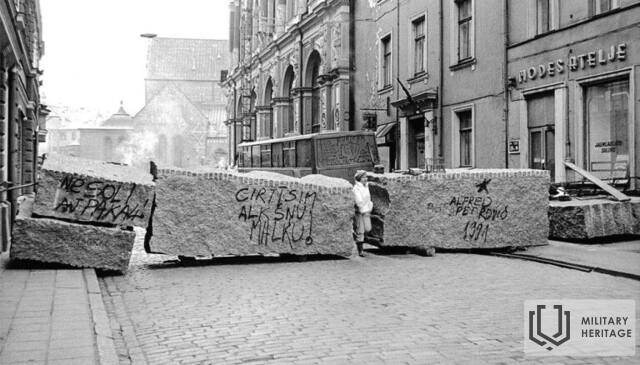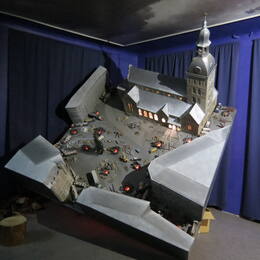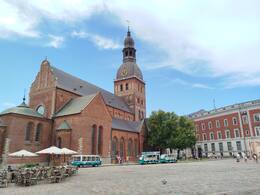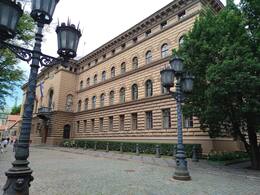From Rezekne to the barricades of 1991
The narrators describe the mood and personal experiences of the Barricades period. The memories well illustrate how information was able to reach the inhabitants of Latvia throughout its territory.
Juris Kudurs: “In 1991, I worked as a teacher at Feimaņi Primary School and was an active member of the Latvian Popular Front. I regularly followed political events in Latvia and the world. When I heard about the events in Vilnius and Daiņš Īvāns’ call to gather at the “All-Latvian Protest Manifestation” organized by the Latvian Popular Front, which would take place on Daugavmala, I had no doubt – I had to go! Pēteris Viļums and I left for Rēzekne by bus early in the morning, where the district committee had already organized buses for the demonstration, which was attended by about 500,000 people, to express support for the Lithuanians and the Latvian government. After the demonstration, Dainis Īvāns and Romualds Ražuks called on people to stay in Riga to protect the most important strategic objects. My duty was to stay in Riga to participate in these events. It was not easy to make such a decision, because a new a woman and a little girl. In the evening, the residents of Riga began to build barricades from concrete blocks and also drove heavy machinery to protect the Supreme Council, the Council of Ministers, Radio in Doma Square, the TV center in Zaķusala, and the Telephone and Telegraph Exchange. Suddenly, I heard a huge noise from the side of the Daugava in Doma Square, it seemed like tanks were driving, they were the first heavy vehicles to start building barricades. The first bonfires also lit up, by which we warmed ourselves on the cold winter nights. During these anxious days and nights, I visited several objects. The most vivid moments remained in my memory, when a militia colonel in Doma Square explained to his men how to stop tanks with crowbars. I saw that bottles of incendiary mixture had been prepared on the upper floors of the buildings. Everyone was preparing for the worst. In the evenings, we felt a sense of community – music was playing, we drank tea, warmed ourselves by bonfires, but "The anxiety of what would happen tomorrow or the day after that never left me. No one had any real clarity, so everyone was waiting to see what would happen next. These events of January 1991 will always remain vivid in my memory and I will be able to tell them to my grandchildren as an eyewitness."
Antons Reiniks remembers: “Since I was a member of the Popular Front, it was obvious to me that I had to go to Riga. The chairwoman of the parish council, Elvīra Pizāne, announced that on the evening of January 14, a bus would be leaving the Rēzekne district council for Riga. Others were also invited, but they excused themselves by saying that they had small children at home and had to take care of the household. Elvīra took me in the parish “Moskviča” to the Rēzekne district council, where men from other parishes had already gathered. On the bus, everyone was advised to write their name, surname and blood type on a piece of paper and put it in their pocket. We knew about the bloody events in Vilnius, there was uncertainty about what would happen, but we had to go. I remember how dashing, patriotic men got on the bus in Dekšāres, and the spirit revived.
We entered Riga around midnight. They took us to Zaķusala near the TV tower. Columns of heavy equipment and log carriers were standing on the Island Bridge. There were already thousands of people at the TV tower, bonfires were burning, music was playing. Firewood had already been brought and we were lighting our own bonfire to warm ourselves at night and be united with the rest of the people. There were fewer people left during the day, but in the evenings and at night the squares were full. Such strong national unity can only exist on barricades. We must thank God, fate and the strength of the people's spirit that today we have our own country and freedom. Let us learn to appreciate it.”
https://rezeknesnovads.lv/tavs-stasts-barikazu-dalibnieku-atminu-stasts/ (viewed 20.07.2021)
Related timeline
Related topics
Related objects
Memorial stone commemorating the 1991 barricades
The first memorial in Latvia to commemorate the 1991 barricade period was made by Valmiera resident Jānis Sprudzāns in his granite products individual enterprise, the foundation was created by SIA “Grods”. The author of the idea for the memorial was Valmiera police major Aleksandrs Melngāršs (1954-2014), who led a group of Valmiera police officers during the January 1991 events in Riga. The sketches and design of the memorial sign were created by Dainis Saulītis. It was unveiled on January 24, 2002. Initially, the memorial sign was placed on the corner of Rīgas and Grants streets on private land, and later in 2010 it was moved to the Vidzeme Regional Administration building of the State Police opposite.
1991 Barricades Museum
The museum is located in Old Riga near the Riga Cathedral. It was founded in 2001 to preserve historical evidence of the events of 1991 in Latvia. A virtual tour of the museum is also available. In January 1991, in Lithuania the Soviet Army opened fire on people who had gathered at the Vilnius TV tower and drove into the crowd with tanks. In response to these events a demonstration of about 500,000 people was organised in Riga to show support to Lithuanians and the readiness of the Latvian people to continue their struggles towards Latvia’s independence. In order to prevent similar events from happening in Latvia, residents began to build barricades in the narrow streets of Old Riga in order to prevent possible attacks of the Soviet Army on the defenders of the barricades. These barricades were also created at various strategic objects not only in Riga, but throughout all of Latvia. Around 50,000 people from all over Latvia participated in defending the barricades. Barricades was a popular movement that helped to regain Latvia’s independence. This is a great example of non-violent resistance in the history of the whole world.
Dome Square in Old Riga
The importance of Dome Square during the Awakening was determined mainly by two circumstances – it was located in the immediate vicinity of the building of the Supreme Council of the Latvian SSR, as well as the fact that the building of Latvian Radio is located on the square. Various actions were held on Dome Square, putting forward demands to the Supreme Council, for example, on July 26, 1989, the Latvian Federation of Labor organized a rally attended by 60,000 people, demanding that the Supreme Council adopt the Declaration of Sovereignty. It was at this rally that the then popular slogan “Something in the past, but in free Latvia” was raised.
Dome Square was the main gathering place for the defenders of the barricades in January 1991, protecting the Supreme Council and the Radio House. The defenders of the barricades warmed themselves by the bonfires. They also stayed in the Radio House and the Dome Church. A first aid station was set up in the church, and services were held. In the evenings, popular rock bands performed on an improvised stage in the square. Every year, events commemorating the barricades are held in Dome Square.
Near the Dome Square, at Krāmu Street 3, there is a museum of the 1991 barricades. On January 13, 2018, the stained glass window “With passion for a free Latvia” by artists Krišs and Dzintars Zilgalvji was unveiled in the Dome Church - a dedication to the 1991 barricades and the independence of Latvia.
Parliament House (Saeima)
The former Vidzeme Knights' House has been the home of the Latvian Parliament since 1922. During the Soviet occupation, a pseudo-parliament - the Supreme Council of the Latvian SSR - was located here. In the elections to the Supreme Council held in March 1990, the main issue was the restoration of Latvia's state independence. This was done in accordance with the position of the Latvian Popular Front, which stated that it was more realistic to do this using the existing power structures of the USSR. In order to win a qualified vote in the Supreme Council, 134 votes were needed.
On May 4, 1990, the Supreme Council of the Latvian SSR adopted the Declaration “On the Restoration of the Independence of the Republic of Latvia”. 138 voted in favor of its adoption, 1 abstained, but 57 deputies who advocated Latvia remaining part of the USSR did not participate in the vote. By adopting the Declaration, the 1922 Constitution was restored in the territory of Latvia, but until the adoption of a new version of the Constitution, its operation was suspended, except for the first three articles of the Constitution. Such a transitional period was determined until the convocation of the Saeima of the Republic of Latvia. May 4 is celebrated as the Day of the Restoration of the Independence of the Republic of Latvia.
On May 15, 1990, opponents of independence attempted to seize the Supreme Council with the help of military cadets dressed in civilian clothes, but the spontaneously organized students of the Polytechnic Institute and the Institute of Physical Culture repelled the attack. The second attempt to attack the Supreme Council was stopped by the militia (the OMON unit, which in June 1990 refused to submit to the government of the Republic of Latvia and became the main strike force of the opponents of independence).
The Supreme Council was one of the most important points of barricade protection in January 1991. The approaches to it were fenced off with reinforced concrete blocks, and these protective structures were there until the unsuccessful coup attempt in Moscow on August 19-21, 1991. Soviet paratroopers and OMON fighters were unable to occupy the Supreme Council, and its deputies continued their work. On August 21, at 1:00 p.m., four OMON armored personnel carriers entered the Dome Square and remained there until 2:10 p.m., trying to intimidate the deputies, who at that time (at 1:10 p.m.) adopted the Constitutional Law on the State Status of the Republic of Latvia (111 deputies voted for, 13 against). This abolished the transitional period established on May 4, 1990 for the de facto restoration of state power in the Republic of Latvia, and Latvia regained full independence. In 2007, a memorial site for the January 1991 barricades was opened near the Saeima building on Jēkaba Street, and in 2000, in honor of the 30th anniversary of the restoration of the independence of the Republic of Latvia, a commemorative plaque was installed next to the main entrance of the Saeima with the inscription: "In this building, on May 4, 1990, the deputies of the Supreme Council adopted a declaration on the restoration of the independence of the Republic of Latvia."
Bastejkalns neighborhood in Riga
The area around Bastejkalns includes several memorial sites from the barricade era. The square, located at the intersection of Smilšu and Torņa streets, opposite the Powder Tower, was named the 1991 Barricade Square in 2016. The heavy equipment stationed here protected Old Riga from invasion at a strategically important location. The nearby Latvian War Museum housed barricade post no. 1.
On January 20, 1991, an OMON attack on the Ministry of Internal Affairs took place in the vicinity of Bastejkalns, which took the lives of several people. In the canalside greenery, opposite Bastejkalns, at the places where the victims were mortally wounded, memorials have been erected - stones to militia lieutenant Vladimir Gamanovič, inspector of the internal affairs department Sergejs Kononenko, director of the Riga Film Studio Andris Slapiņš, schoolboy Edijs Riekstiņš and the shot cameraman Gvido Zvaigznes, who died on February 5. There is a version that the shooters were not only and not so much OMON members, but also some “third force” - either from the special unit “Alfa”, or employees of the USSR State Security Committee from Moscow, who provoked the OMON attack on the Ministry of Internal Affairs.
A memorial stone has also been installed in the canalside gardens to the victim of August 19, 1991, Raimonds Salmiņš, who was shot by riot police near the Riga City Police Department building at the intersection of Aspazijas Boulevard and 13. janvāra Street. In 2014, a memorial plaque dedicated to the victims of the January 20, 1991 attack on the Ministry of the Interior was installed near the former Ministry of the Interior building at the corner of Raina Boulevard and Reimersa Street.







![A memorial stone commemorating the 1991 barricades on Rīgas Street in Valmiera. Source: Valmiera [illustrated edition], published by Jumava Publishing House, 2008. - p. 87. Author: Nils Smelteris.](/g/Poi/00540/Dzelzcela-tilts-Valmiera_1922g2.jpg?size=260)



